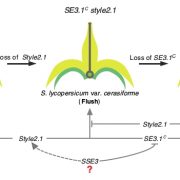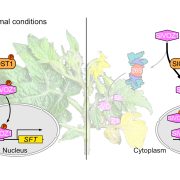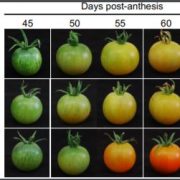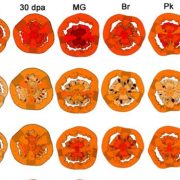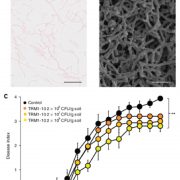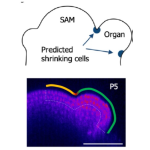Blue light, PAS/LOV photoreceptor and GDP-L-galactose phosphorylase (GGP): the Triumvirate controlling ascorbic acid biosynthesis in plants
Bournonville et al. explore which factors control ascorbic acid biosynthesis in plants and its accumulation in fruits.
https://doi.org/10.1093/plcell/koad108
Céline Bournonville, Bayer SAS, 1050 Route de Pardies, 40300 Peyrehorade, France
Kentaro Mori, Université Bordeaux, INRAE, UMR Biologie du Fruit et Pathologie, 33883 Villenave d’Ornon, France.
Pierre Baldet, Université Bordeaux, INRAE, UMR Biologie du Fruit et Pathologie, 33883 Villenave d’Ornon, France.
Background: Ascorbic acid, also known as vitamin C, is an essential antioxidant with key roles in several stress responses in living organisms. Since humans are not able to produce this molecule, we must obtain it through our diet, with plant products being the main source. Although the plant biosynthetic pathway of ascorbic acid is well known, the molecular mechanisms that regulate it are not yet understood. Among these regulatory factors, light occupies an important place, since it is vital for plants and it is well established that the more light there is, the more ascorbic acid plants produce and vice versa. However, the underlying mechanisms remain totally unknown.
Question: What are the factors that control ascorbic acid biosynthesis in plants and more particularly its accumulation in fruits?
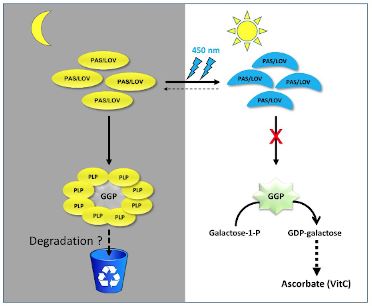 Findings: Our work uncovers the mechanism by which plants use blue light to modulate ascorbate biosynthesis. From a tomato mutant, we identified a photoreceptor named PAS/LOV (PLP) and revealed that it functions as a negative regulator in vivo and in vitro by interacting with the GDP-galactose phosphorylase (GGP), which is known to be the most controlling enzyme of the pathway. We also demonstrated that blue light counteracts the inhibition of the GDP-galactose phosphorylase by the PAS/LOV photoreceptor. This is a major finding because it finally explains how plants protect themselves from too much light by synthesizing more of their main antioxidant.
Findings: Our work uncovers the mechanism by which plants use blue light to modulate ascorbate biosynthesis. From a tomato mutant, we identified a photoreceptor named PAS/LOV (PLP) and revealed that it functions as a negative regulator in vivo and in vitro by interacting with the GDP-galactose phosphorylase (GGP), which is known to be the most controlling enzyme of the pathway. We also demonstrated that blue light counteracts the inhibition of the GDP-galactose phosphorylase by the PAS/LOV photoreceptor. This is a major finding because it finally explains how plants protect themselves from too much light by synthesizing more of their main antioxidant.
Next steps: Future research should study the turnover of GGP in relation to PLP, particularly to better understand the adaptive role of PLP. Such research would open up new ways for developing plants that are more resistant to stress, fruits with prolonged “shelf-life”, and even plants with enhanced nutritional profiles.
Reference:
Céline Bournonville, Kentaro Mori, Paul Deslous, Guillaume Decros, Tim Blomeier, Jean-Philippe Mauxion, Joana Jorly, Stéphanie Gadin, Cédric Cassan, Mickael Maucourt, Daniel Just, Cécile Brès, Christophe Rothan, Carine Ferrand, Lucie Fernandez-Lochu, Laure Bataille, Kenji Miura, Laure Beven, Matias D. Zurbriggen, Pierre Pétriacq, Yves Gibon and Pierre Baldet. (2023). Blue light promotes ascorbate synthesis by deactivating the PAS/LOV photoreceptor that inhibits GDP-L-galactose phosphorylase. https://doi.org/10.1093/plcell/koad108


